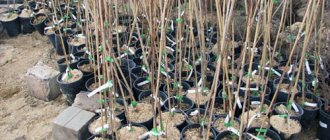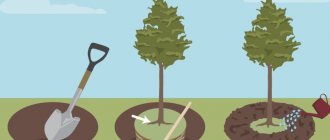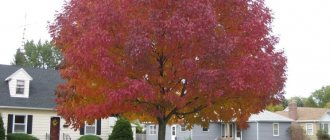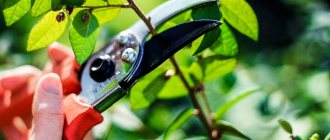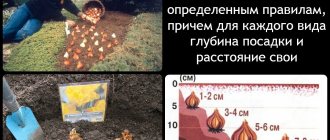Home » Garden and vegetable garden » Fruit trees
Margarita Merkusheva 09/30/2019
1835 Views
Planting fruit crops does not bypass anyone, neither the owners of empty land, nor the owners of luxury plots. Some are making their dreams of a beautiful garden come true, others are rejuvenating the existing one. For all necessary work, there are rules that determine the best time to plant fruit trees.
It's the right time
Planting time depends on the region and type of tree
The following points influence the landing season:
- What type of plant is the plant being planted?
- How favorable is the weather of the selected season?
- From the region where cultivation will take place
- From soil type
Fruit crops are divided into types:
- stone fruit
- pomaceae
- Favorable time for planting fruit trees by region:
| Mid latitudes | stone fruit types – spring pome types – autumn |
| Southern regions | all types – autumn |
| Northern regions | all types – spring |
Fruit trees
Cherry, plum, apricot, cherry plum, sweet cherry are plants that love warmth. They belong to the stone type. In areas of the middle zone, this species cannot take root in the autumn before the winter cold sets in. Therefore, the best time to plant it for these regions is spring (from the 2nd half of March to mid-April).
The most popular representatives of the pome type are pear and apple trees. They are not demanding in taking care of themselves and are more resistant to cold weather. In middle latitudes they are planted in the fall before frost (1-1.5 months). If early frosts occur or autumn precipitation continues for a long time, then planting is postponed to the spring season.
Seed-type planting is carried out in spring and in areas with short summer and autumn seasons (northern regions and risky farming zones). During these periods, all types of plantings do not take root well here.
Autumn tree planting
In the southern regions, all types of fruit trees are planted in the fall , because... cooling here occurs in November or even in mid-December. And with the onset of heat, this is not the best period for rooting small trees due to dry weather conditions that occur very early.
If heavy soil predominates in the garden area, the planting of seed-type crops is postponed to the spring , and in the fall planting holes are prepared to adjust the soil structure.
Adviсe:
- During periods of prolonged rains, prolonged drought and during recurrent spring frosts, it is not recommended to work with planting material
- autumn planting is carried out before the winter cold sets in (at least a month in advance)
- heavy soil is not suitable for arranging a garden plot, so planting seedlings should be postponed until the spring
When to plant fruit bushes
The best time to plant fruit bushes is autumn. This is due to the fact that these plants enter the growing season very early in the spring, even before the ground completely thaws. In most cases, planting shrubs in the spring ends in failure. If the situation is hopeless, you need to try to plant in spring as early as possible, immediately after the snow melts. To increase survival rate, planted seedlings are watered intensively, maintaining constant soil moisture.
Important! At first, it is recommended to protect the planted cuttings and shrub seedlings from direct sunlight, artificially shading the place where they are planted.
We do not exclude the summer period
A seedling with a closed root system can be planted in summer without harm
Modern gardeners do not always follow the rules. This also applies to the arrangement of the garden plot, namely planting fruit plants in the summer season. Moreover, today this can be done without harming small trees.
Heat is not a favorable condition for normal rooting. This is detrimental to bare-rooted planting material. He will feel more comfortable if the temperature around him is low and the soil is well saturated with moisture.
Today, plant growing establishments sell seedlings in containers. The root system of such a tree is in a soil mixture that is good for it, which protects it and prevents it from drying out. Therefore, it does not matter what the temperature will be during disembarkation.
The installed automatic watering system on the site makes the summer period (namely June) the preferred time for planting seedlings. The specific day is selected according to the lunar calendar. The most favorable period is the 2nd and 3rd quarter of the Moon's activity.
Soil temperature also matters. It should not exceed 250C. If the weather is hot, planting work is carried out early in the morning (before 8.00) or late in the evening (before sunset). This way it will be possible to prevent the roots from burning and create conditions for better adaptation of the tree.
Planting a pear
Benefits of summer planting:
- leisurely opportunity to select a seedling, because in summer, nurseries do not have a large influx of visitors
- The growing season is the best moment to evaluate all the advantages of the purchased planting material
- trees planted in the summer have a better chance of taking root before the cold weather sets in than their counterparts planted in the autumn season
During the summer planting period, all ovaries on the seedling are removed. This will make it stronger, which will allow it to endure the winter more steadfastly.
What to do if you didn’t have time to plant in the fall?
It happens that it is not possible to buy the right, interesting variety on time, or garden material ordered by postal delivery arrives too late, when the last deadline for autumn planting has already passed. Or, as is the case with stone fruits, which in the central region are planted only in the spring, and seedlings are purchased in the fall. The question arises, how to preserve them?
Storage by digging
Experienced gardeners leave seedlings directly on the site using the digging method. As a rule, they choose a bed free of vegetables in a flat, dry part of the garden and dig a trench in the west-east direction. Its depth is 50 cm, width – 30 cm.
Plants are prepared for planting: leaves are removed, damaged roots are trimmed, and the root system is immersed in a bucket of water for several hours. The seedlings are placed in a prepared trench with their roots to the north and branches to the south. The roots are sprinkled with a 30 cm layer of soil and watered generously. And just before frost, they dig in almost completely, leaving only the tops. A layer of sawdust, leaves, and pine needles is poured on top. In winter, snow is thrown over the pit.
We invite you to watch a video demonstrating the digging method:
In the spring, when the soil begins to thaw, the overwintered trees are carefully dug up, piece by piece, and planted in a permanent place in planting holes prepared in advance, preferably in the fall.
The cellar will help out
If the house has a cellar or a cool basement, underground, you can save planting material there too. The root system is moistened. The plant is placed in a container (buckets, pots, boxes) with moist soil (soil mixture, sawdust, peat).
Instead of solid containers, it is convenient to use thick plastic bags with several holes for aeration
A tree exposed to light after storage may get sunburned. Preliminary adaptation is necessary: the seedlings are placed in partial shade for several days, then planted.
In addition to the planting date, successful survival is influenced by a number of factors: the choice of location on the site, the type and fertility of the soil, the variety, the condition of the seedling, proper planting and subsequent agrotechnical methods for cultivating a particular crop.
Location
Rational use of territory
Often gardeners are overly concerned about the quality of the soil and do not think through the plan according to which trees will be planted. By doing this they are making a big mistake, because... Soil type can be adjusted as planting holes are formed.
But how the plantings will be illuminated and how well ventilated is of great importance .
In order for the trees to be well nourished and receive sufficient moisture, they should not be planted close to each other.
Shading of plantings by the crown of an adult plant increases the risk of developing various infections (fungi, viruses) in the area and complicates the pollination stage during flowering. All this will affect the volume of the harvest and the size of the fruit.
If you follow the planting plan, this will make it easier to care for trees in the future, trim them, and spray them. Before forming planting holes, a diagram must be drawn on paper calculating the density of future plantings.
When planting crops in a single copy, special attention is paid to their distance from any garden buildings and equipped paths.
Planting seedlings
The interval between planting fruit seedlings among themselves and from outbuildings:
| Vigorous varieties | minimum 5-6 m |
| Medium-sized varieties | 4 m |
| Low-growing trees (columnar, dwarf) | 2-3 m |
To rationally use the territory, berry crops (strawberries, currants) are placed between the fruit trees.
The solar illumination of the garden where the plantings will be arranged should be at least half of the daytime . During the first years, young seedlings are afraid of drafts, and their roots need unhindered access to moisture.
Crops that produce fruit consume moisture in large quantities. It is advisable to locate them in places where the groundwater level is high.
How to plant?
When thinking about planting fruit trees, do not forget that the planting plan should not contradict the general concept of landscape design of the site. It is not at all necessary to place all the trees in one place; you can picturesquely “scatter” them around the site. But to take into account all the nuances, it is better to consult an experienced landscape designer.
And of course, the planting plan should be thought out in advance. Here it is important to keep in mind the composition of the soil, the illumination, and the distance between the trees (in different species and varieties of fruit trees, both the crown and the root system grow differently, which must be taken into account, otherwise an adult tree may interfere with its neighbors).
The landing algorithm itself is easy to find on the Internet or other sources. Let us separately dwell on some of the nuances of planting in spring, which gardeners often forget about.
- Never use fresh manure for fertilizer - it will burn the root system of the plant. The best option here is last year’s manure, fermented or compost. You can also use store-bought manure-based fertilizers.
- When you cover the roots with soil, do not forget to straighten them, and also shake the seedling periodically so that voids do not form under the roots.
- The roots should not remain on the surface, but you should not deepen the plant too much. The best option is when the root collar of the seedling (the place where the plant trunk meets the roots) is at ground level.
- It is better to fix the support for the seedling until the plant is planted, so as not to damage the roots. Just drive it into the bottom of the hole, and then place the tree so that the support is on its northern side - this way it will also protect the young bark of the tree, which is not accustomed to the bright sun. Remember that the upper limit of the support should be below the beginning of the growth of the branches.
- If the place chosen for planting the tree is damp, add a mound of soil before planting to prevent rotting of the roots.
The most important thing to remember is that skill comes with experience. Of course, you are unlikely to get by completely without mistakes, especially if you are planting a garden for the first time. In this case, before starting work, it is better to consult with an experienced gardener or landscape designer, which is even preferable: a specialist will look at your idea from all sides and find weak spots in it that you most likely do not notice yourself.
In any case, even if you have no one to consult with, do not under any circumstances give up on your dream of your own orchard. Draw a planting plan on paper, write down separately everything that may be important, carefully analyze your plan again and go for it! You will definitely succeed.
Selection of planting material
Fruit tree seedlings
The best place to purchase fruit seedlings is nurseries. Here, trees are grown following all the rules of agricultural technology, and consultants will explain in detail how to plant and how to care for a particular variety.
The risk that the purchased seedling is infected with pests and infections in such institutions is reduced to zero.
Sapling with bare root system
Open root system
When purchasing planting material whose roots are exposed, it is important to keep an eye on the following points:
1to ensure a high probability of tree survival, varieties suitable for a given region are selected
2 the healthy condition of the material is indicated by roots with an abundance of shoots; a sign of the disease is a brown tint of the rhizome and layers on it
3The length of the rhizome should be at least 25-30 cm, and the stem should not have any defects
4 it is necessary to preserve the seedling in a damp cloth with which its roots are wrapped (if the rhizome dries out, it is soaked in settled water for 1-2 days with the addition of a drug to stimulate development or to resuscitate the weakened plant)
5By purchasing planting material with exposed rhizomes, you can not only save money, but also consider more carefully what you buy in detail. Although its survival rate may be worse when compared with the material in a lump of soil mixture.
Sapling in a container
Sapling in a container
Buying a tree in a container means there is a greater chance that the plant will take root. But checking the viability of the material is necessary:
- All external parts of the seedling (bark, branches) are carefully inspected. The vegetative mass (if any) should have rich and uniform color
- The pot is turned over and the bottom is inspected for the presence of strong roots that grow through the drainage holes
- The tree is carefully lifted by the root part of the stem . Free release from the container indicates that it was transplanted a long time ago and that the root system has been well developed during this time. During recent transplantation of seedlings in places for growing plants, the roots are cut so that they fit into the transport pot
Distance to the border when planting fruit trees
When planting fruit trees on your site, it would be useful to familiarize yourself with the legislative acts of tree planting in order to maintain good neighborly relations. Thus, the standards stipulate that the distance from a perennial plant to the border of the site should be at least 3 meters for short trees.
The larger the diameter of the crown, the greater this distance becomes, because neighbors can rightfully remove tree branches and roots extending beyond the boundaries of your site without your consent. Bushes can be planted at a distance of 1 meter from the border, and plums, peaches, cherries - 2 meters.
Preparing planting holes
We prepare the planting hole in advance in compliance with the required dimensions
The most optimal solution is when the holes for planting are prepared in advance, i.e. if planting is planned in the spring, the hole is prepared in the fall; for autumn planting, preparations begin in the spring season.
If the deadlines are missed, the formation of holes is possible half a month before planting. During this time, the soil will subside and all empty spaces that could cause root rot will disappear.
All types of fruit crops and fruit and berry bushes begin to vary in size with age (2-3 years). For this reason, the size of the prepared holes for each type is different:
| Planting material | Depth, cm | Diameter, cm |
| Pome type with bare rhizome | 60 | 90-100 |
| Stone fruit type and shrubs | 40-50 | 75-80 |
| Closed root material | 60-80 | 100 |
In order for the seedling to begin to bear fruit faster, the hole for it must be wide and shallow.
Planting fruit trees
Holes about 1 m wide and 60-80 cm deep are made in areas where the soil is heavy, because nutrients (the main part of them) are located in the surface layer, the most fertile . If the roots are too deep, the tree will not be able to feed and adapt normally.
The process of digging a hole:
1 A peg is driven into the central part of the proposed hole, onto which a cord with a metal rod is tied. They will draw the required circle
2Digging a hole
3The excavated soil is laid out on different sides: in the 1st - the upper dark fertile layer, in the 2nd - the lower lighter layer
4If necessary, the surface layer is adjusted: to heavy soil - add 1 bucket (partial) of sand, to light soil - chernozem or soil from the garden, diluted in equal proportions with peat
5Acidic soil, 10-15 days. Before planting the tree, it is limed with dolomite flour or chalk. Fertilizer is applied when planting
Planting dates according to the lunar calendar
The lunar calendar is based on periods of changing phases of the Moon, that is, synodic months. Many amateur gardeners actively use the lunar and lunisolar calendars to determine the best time to plant plants in spring or autumn in the garden.
According to the lunar calendar, it is not recommended to plant and replant fruit and berry plants during the full moon . In order to plant seedlings correctly and get a healthy and abundantly fruiting fruit or berry crop, it is advisable to adhere to the deadlines indicated in the table.
| Garden culture | Planting days in March | Planting days in April | Planting days in May |
| Apricot, cherry and plum seedlings | 1 and 2 28 and 29 | 2 and 3 29 and 30 | 3 and 4 30 and 31 |
| Quince and pear seedlings | 1 and 2 6 and 7 | 2 and 3 29 and 30 | 3 and 4 23, 27 and 28 |
| Hawthorn seedlings | 2 and 7 29 | 3 26 and 30 | 23, 27 and 28, 31 |
| Seedlings of serviceberry, viburnum and sea buckthorn | 6 and 7 | 25 and 26, 29 | 4 27 and 28 |
| Gooseberry, raspberry and currant seedlings | 7 28 and 29 | 3 25 and 30 | 23, 27 and 28, 31 |
| Apple tree seedlings | Landing is undesirable | 2 and 3 25 and 26 29 and 30 | 3 and 4 27 and 28 30 and 31 |
| Cherry seedlings | 7 and 29 | 2 and 3 25 | 3 and 4 27 |
Disembarkation rules
Feeding with ash
Mineral-organic mixtures or chemical additives are added to the planting material, but organic matter is not added. When using organics, nitrogen agrochemicals are not used.
For seed types, several types of fertilizers are applied into a hole with a diameter of 1 m and a depth of 60 cm, which differ in composition:
1 Rotted compost – 4 buckets (10 l each) / simple superphosphate – 400 g (double – 200 g) / potassium sulfate – 200 g
or
2 Humus – 3 buckets / bone meal – 1 kg / simple superphosphate – 200 g / potassium sulfate – 200 g
In the cold season, potassium sulfate can be replaced with potassium chloride if desired. Instead of chemicals, ash is used for environmentally friendly cultivation in the following proportions: 1 hole / 1 liter of ash.
For stone fruit types, fertilizing is introduced into a hole up to 80 cm in diameter and 40 cm deep, reduced in volume by 2 times.
Cherry planting
The process of planting a seedling with a bare rhizome:
1The bottom of the pit is filled with a nutrient mixture, which is prepared from half the amount of the fertilizer mixture and part of the soil from the upper layer. A cone-shaped mound is formed from the mixture
2 Planting material is placed on the mound. Its roots are evenly placed in a circle
3The second half of the fertilizer is poured onto the roots. The seedling is gently shaken to prevent possible empty space between the roots.
4Water is poured at the rate of: 1 hole / 2-4 buckets (depending on the age of the tree)
5The recess is filled with the remainder of the soil from the upper layer to the level of the root collar. The root fossa is formed from the lower layer along the edges of the trunk circle
6The tree is watered, with the stream directed into the root hole
7Using leaves, straw, and mown grass, the tree trunk circle is mulched. Chips and sawdust are used as a mulch covering on alkaline soils.
If you deepen the root collar, the tree will not begin to bear fruit soon. The best option would be not to close the neck, but to correct the defect by simply adding fertile soil.
Saplings with bare rhizomes
The process of planting a plant with a hidden root system is simpler compared to the previous option:
1Initially, half of the feeding mixture is also mixed with ½ part of the fertile layer of soil. All this is placed at the bottom of the prepared recess.
2The plant is placed in the hole along with a lump of soil in which the root system has already been formed.
3The remaining fertilizer is distributed along the edges and watered well
4The hole is filled with soil remaining from the top fertile layer
5Everything is watered again
6Trunk circle is covered with mulch
Choosing a landing site
Fruit trees are grown in areas that are illuminated by the sun and protected from drafts and wind; gardens are set up on southern slopes. Fruit tree seedlings do not take root in wetlands and flooded lands, and do not develop well near tall buildings.
Preparing the planting hole
The area selected taking into account the recommendations for growing fruit trees is cleared of debris and a hole is dug in the fall, the size of which is determined by the size of the root system of the seedling. In most cases, a depth of up to 80 cm and a diameter of 0.5 to 1.0 m are sufficient. The earth that is removed from the hole is combined with the same amount of humus and 1 tbsp is added. spoon:
- ash;
- urea;
- superphosphate.
All components are mixed and used when planting a tree in the spring. In an area where groundwater comes close to the surface, a drainage layer of crushed stone, stones or expanded clay is poured onto the bottom of the planting hole, and a mound of nutritious soil is built. The support is hammered in already in the spring.
At what distance should fruit trees and shrubs be planted?
To prevent plants from shading each other and from taking away the substances necessary for development and subsequent fruiting, maintain a distance between fruit tree seedlings of 2.5 to 3 meters, and between berry bushes from 1.5 m. Plants are placed near buildings at the same interval .
Rules of care
The first couple of seasons require sufficient and systematic watering.
For the first couple of seasons, all types of fruit trees require sufficient and systematic watering, even if the seedlings were planted in the fall. Watering stops only when cold weather sets in.
The inflorescences of the first flowering are removed. The fruit tree will spend a lot of energy on inflorescences and fruit formation, and the development of the root system and crown will stop.
During the first 3 years, formative pruning of the trunk will be required, as well as regular spraying with special preparations that protect the young seedling from pests and diseases.
In winter, the tree trunk circle is mulched to protect young roots from frost. The trunk also needs to be wrapped with a special covering material that will protect it from frostbite and rodents.
Whitewashing will protect against sunburn and will prevent garden pests
With the onset of spring, the trunk becomes white. This will protect it from sunburn and will prevent garden pests.
Growing a garden that will bear fruit abundantly requires a lot of effort and patience. Each stage of fruit crop development requires careful care.
To begin with, take care to determine the optimal time for planting, purchase a healthy seedling and properly prepare the planting hole. Only if all conditions are met can you get a wonderful harvest.
Planting fruit tree seedlings in autumn
Although spring planting is most often practiced, autumn planting also has its advantages (Figure 4). For example, in the fall it is much more profitable to purchase seedlings, since there is an opportunity to see the fruits that a certain variety produces. In addition, seedlings planted in autumn do not require much trouble; watering in dry weather conditions will be sufficient. Their roots will continue to grow until the onset of stable frosts, which means that such a tree will grow earlier in the spring.
Figure 4. Rules for planting fruit crops in autumn
Most often, autumn procedures are practiced in the southern regions, where young plants are not at risk of hypothermia due to mild winters. However, you should remember the vagaries of nature and understand the risk to the growth of autumn plantings. Severe frosts and wind, ice and snowfalls can not only damage seedlings, but also completely destroy them. Therefore, experts advise not to plant fruit crops such as pear, apple, plum, apricot, peach, sweet cherry, almond and cherry in the fall.
Deadlines
The optimal time for autumn planting is the end of September - October, and in the southern regions - from October to mid-November. However, you should know that these terms are quite arbitrary, since they depend on weather conditions.
Therefore, it is still better to navigate by the condition of the seedlings. The best time for planting is the dormant period, which occurs after the end of leaf fall.

